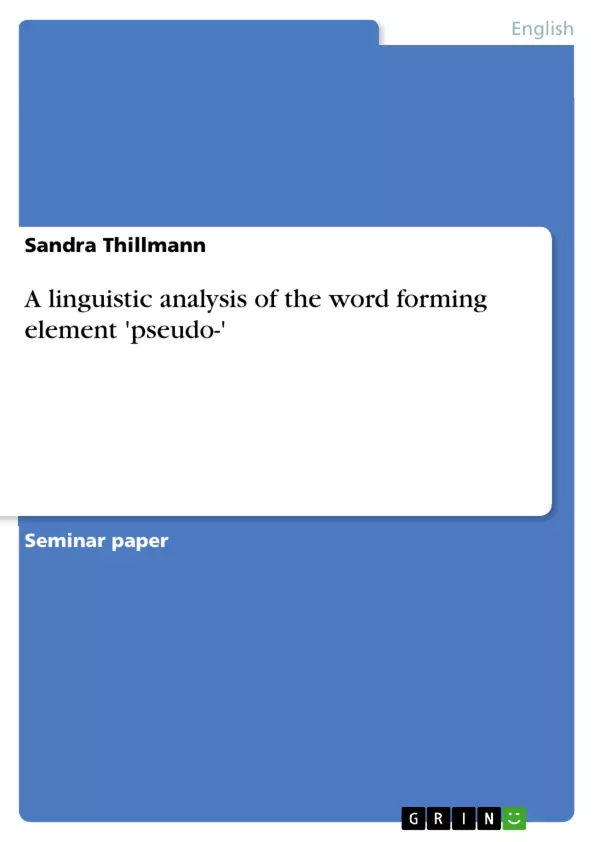In this term-paper I will examine the German word-forming element pseudo-/Pseudo- in order to find out about its meaning and function, its properties but also about its transparency and productivity.
First of all I describe the procedure of collecting data and go into some essential basics. I will handle this in chapter two: Methodology. In chapter three I highlight meaning and origin of the element with information from dictionaries. Chapter four is about the dif-ferent properties of pseudo-. The subparagraph “morphological and syntactic proper-ties” deals with the classification of morphemes according to Kortmann but also with the lexical category of the base and with the finding of particular suffixes. The phono-logical properties offer an analysis concerning syllables, stress pattern and pronuncia-tion whereas the semantic properties is about pseudo- as an pejorative prefix. Chapter five is called “morphological status” and here I make a discussion about combining forms. In chapter six “transparency”, I define this term and describe how transparent the element is. The chapter of frequency and productivity (Chapter 7) is about how of-ten the element occurs and from this it follows a debate about its productivity rate. In the last chapter I compare pseudo- with möchtegern- and analyze it concerning a certain rivalry between the two morphemes.
The analysis of the element pseudo- is based on the data collection of several corpora. I used the online dictionary and linguistic data base DWDS (Das Digitale Wörterbuch der deutschen Sprache des 20. Jh.). One of the eight corpora that the DWDS provides is called Corpus Berliner Zeitung. This corpus contains all online articles that have been appeared in the Berliner Zeitung from 3.1.1994 to 31.12.2005. It’s scale is about 252 million tokens in 869.000 articles.
I searched for pseudo* and I got 9 pages full of different pseudo-combinations. I tried to sort out the words that were not useful regarding to my analysis. Therefore I elimi-nated proper nouns or word formations that are well-established. For example pseudois-idorische Dekretalen (kirchenrechtliche Fälschungen) or pseudocýperus (Pflanzen-name). I put the words that can be found in a dictionary in brackets and therefore I did not include them in my analysis because dictionary words are not useable concerning an analysis of neologism.
Table of Contents
- INTRODUCTION
- METHODOLOGY
- MEANING AND ORIGIN
- PROPERTIES
- Morphological and syntactic properties
- Phonological properties
- Semantic properties
- MORPHOLOGICAL STATUS
- TRANSPARENCY
- FREQUENCY AND PRODUCTIVITY
- COMPARISONS, RIVALLING ELEMENTS
Objectives and Key Themes
This term-paper examines the German word-forming element pseudo-/Pseudo- in order to gain insights into its meaning and function, properties, transparency, and productivity.
- Meaning and origin of the element
- Morphological, syntactic, phonological, and semantic properties
- Morphological status of the element as a combining form
- Transparency of the element in compound formation
- Frequency and productivity of the element
Chapter Summaries
The analysis of the element pseudo- is based on data collected from the online dictionary and linguistic data base DWDS (Das Digitale Wörterbuch der deutschen Sprache des 20. Jh.) and the world wide web.
Chapter two, Methodology, describes the process of collecting data and outlines essential basics. Chapter three, Meaning and Origin, provides insights into the element's meaning and origin based on information from dictionaries. Chapter four, Properties, delves into the different properties of pseudo-, focusing on its morphological and syntactic classification, phonological characteristics, and semantic function as a pejorative prefix. Chapter five, Morphological Status, discusses the element's status as a combining form within neoclassical compounds.
Chapter six, Transparency, examines the element's transparency in compound formation, highlighting its endocentric nature and semantic clarity. Chapter seven, Frequency and Productivity, analyzes the frequency of occurrence of pseudo- and explores its productivity rate by analyzing hapaxes and observing trends in its use over time.
Chapter eight, Comparisons, Rivalling Elements, compares pseudo- with the similar element möchtegern- and analyzes their respective frequencies and distributions in the corpora.
Keywords
The primary terms and concepts investigated in this work include: pseudo-/Pseudo-, word-formation, morphology, syntax, phonology, semantics, combining form, transparency, frequency, productivity, neologism, hapaxes, corpora analysis, DWDS, Google, German language.
- Quote paper
- Sandra Thillmann (Author), 2007, A linguistic analysis of the word forming element 'pseudo-', Munich, GRIN Verlag, https://www.grin.com/document/88693



